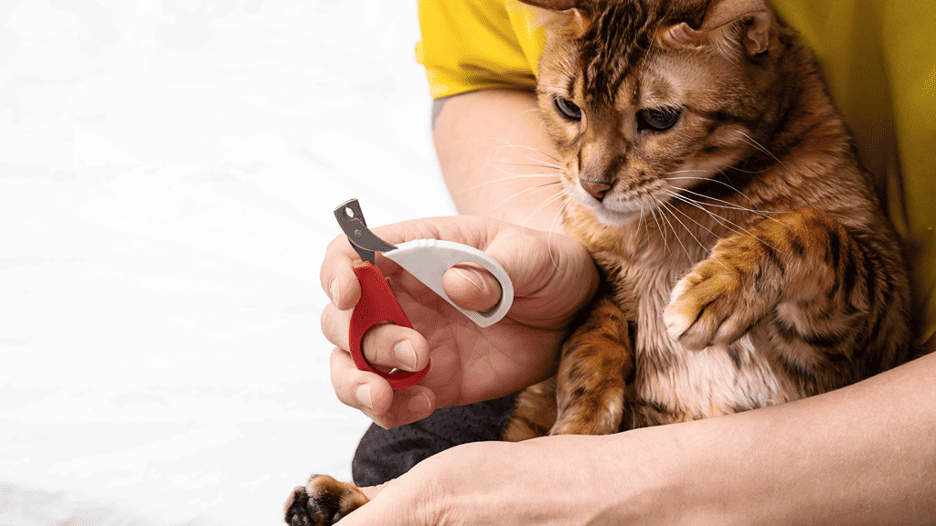9 Alternatives To Declawing A Cat

Cats use their claws like we use our fingers. When a cat gets declawed, it’s as if our fingers were cut off at the knuckles. If declawing sounds gruesome, that’s because it is. Some people call it feline toe amputation. Years ago, this practice was considered normal, but today, countries around the world have banned the declawing of cats. A lot of cities and states across America ban this practice as well. Still not convinced? Check out this information to discover why declawing cats is not a good option for your cat, and learn about nine alternatives to keep your kitty happy and healthy.
What Is Declawing?
The declawing of cats began in the 1950s as more cats were being kept indoors, partly due to the invention of kitty litter. Surprisingly, there was little to no research about the effects declawing would have on a cat. The declawing procedure is done with a tool called a guillotine clipper. It’s a major surgery that involves removing the last bone on each of a cat’s toes to prevent the claws from growing back. After the surgery, the wounds are stitched and bandaged. Some declawing procedures are performed with high-heat laser beams that cut out the claws with heat and vapor. Both methods can leave physical or emotional scars on cats.
Why do cats scratch?
Scratching isn’t bad behavior. It’s normal cat behavior. Cats instinctively scratch for several reasons, such as to:
- Release their scent (there are scent glands in a cat’s paws)
- Relieve stress
- Remove dead layers of claws
- To stretch their feet
- Mark their territory
Declawing doesn’t take away a cat’s instinct, making it impossible for your cat to live normally.
Why Declawing A Cat Could Have Long-Term Risks
Declawing can have many long-term risks for a cat. Here are just a few risks that could occur after declawing a cat.
- Lifelong pain – Some cats experience not only post-surgery pain but lifelong pain. Declawing causes arthritis in the areas where they removed the bones. When a cat is declawed, it causes them to walk unnaturally, which leads to pain.
- Stress – Cats are easily stressed. Scratching is a normal way for cats to relieve their stress. Without the ability to destress, your cat will likely act out or get anxious. Cats stretch their bodies by scratching. They also deposit a scent from their paws when they stretch. When a cat can’t scratch, it disrupts this natural way of relieving stress.
- Behavior problems – When a cat is in pain, it can change its personality. A cat that was friendly and sweet becomes withdrawn and mean. They’ll be upset all the time. Your cat may urinate outside their litter box because they think their paw hurts from scratching the kitty litter.
- Lack of self – defense-Cats use their claws to protect themselves. Although indoor cats rarely need this defense, they need help defending themselves if they accidentally slip outside.
As you can see, there are many negatives to declawing cats. Listed below are some potential alternatives to declawing your cat.
9 Alternatives to Declawing a Cat
Fortunately, there are some great alternatives to declawing your sweet pet. Here are nine suggestions to consider.
Temporary Synthetic Cat Nail Caps
A good alternative to declawing your cat is soft nail caps. These are painless and temporary hollowed-out soft caps that fit perfectly over a cat’s nails. Made in the shape of cat nails, they are glued over the nail, similar to how salons apply artificial nails. These cat nails come in a variety of colors, and some even have glitter for an extra touch of glam for your feline friend. If your kitty doesn’t sit still for you to apply them, pet groomers and even some vets may be able to apply them. Take your cat to a professional for application if you aren’t feeling confident about doing it at home. The synthetic cat nails will need to be reapplied after 4 to 6 weeks.
Scratching Surfaces
Scratching surfaces are another great alternative. These surfaces are designed to give your cat a scratching experience without damaging your home. Different cats prefer different scratching mediums. Try different ones to see what your cat prefers. Options include
- Carpets
- Cardboard
- Twine
- Wood
Once you choose a scratching pad, post, or shelf to entice your cat’s scratching habits, then find a location where your cat seems to like to scratch, such as next to a piece of furniture. You can use a spray like Feliway on the scratching surfaces you want your cat to use. The spray entices them to scratch in appropriate locations. Be sure the pad is big enough for your cat to stretch out and scratch. Reward your feline friend when they use their pad for scratching. This will reinforce their desire to use the pad.
 Regular Nail Trimming
Regular Nail Trimming
It’s important to keep your cat’s nails well-trimmed. Your cat won’t enjoy the process of nail trimming, but it’ll go fairly quickly with the right tools. Some kits include the necessary equipment to trim your feline’s nails. The important part of nail clippers is to make sure they’re sharp. Using dull clippers can cause the nail to split and hurt your cat. Replace the clippers if they no longer make clean, quick cuts. Some cat parents prefer a Dremel-type hand grinder instead of a cutting tool. These are noisy, but we’re less likely to hit the quick of the cat’s toenail, causing damage or pain for your cat. Be sure to reward your cat after each nail trim. This helps it be more of a positive experience for them.
Anti-Scratch Booties
Small silicone booties placed on your cat’s feet keep them from scratching when a child or older adult visits your home. It’s a short-term option but an effective one. You may need to practice putting on the booties so your cat gets adjusted. Anti-scratch booties come in all colors and designs. Choose the design that fits your cat best. Reward your kitty when you put them on and when they leave them on. Be sure to remove them immediately when your visitors are gone.
Loving Communication
It’s possible to train your cat not to scratch with some loving communication. Be patient with your kitty as they learn. Try to include lots of hugs and rewards when you’re trying to help them learn. Your cat will sense your frustration and become stressed if you get frustrated or irritable. Make sure your training times are short and sweet to keep your cat interested but stay calm. Showing your cat you love them goes a long way in helping them learn from you.
Pheromone Sprays
Have you heard of feline pheromone spray? These sprays mimic a cat’s natural phenomes, which send calming messages to your cat. The sprays calm cats and relieve their anxiety and stress. Spray the pheromone spray on your cat’s scratch pad or post to attract them to the area. They will be drawn to these places to scratch instead of your furniture.
Consider Furniture Deterrents
Another alternative to clipping a cat’s nails is to come up with furniture deterrents to keep your cat from scratching. Place deterrents on your cat’s favorite furniture that they like to scratch. The best deterrents are
- Sticky paws tape
- Aluminum foil
- Plastic car mats on furniture
- Double-sided tape
- Blankets laid on the furniture
- Spray deterrents
- Natural oils that cats don’t like, such as cinnamon or rosemary, keep them away from furniture you don’t want to be scratched.
These things will discourage your cat from trying to scratch the furniture. Of course, you’ll need to provide alternative places for your cat to scratch, such as scratching posts or pads.
Keeping Cats Entertained When You’re Away
Keeping your cat busy and happy when you’re gone is important because a bored cat will scratch for something to do. Find interactive puzzles or toys for your cat to play with. Things that will keep your cat entertained when you’re away could include
- Food puzzles
- Motion activated toys
- Moving balls
- Cardboard boxes
- Catio-this is a screened-in area for your cat to feel like they’re outside, but much safer.
- Cat television-Yes, it’s a thing. Certain channels provide unlimited videos of birds or cats playing.
Temporarily Restrict Surfaces
The last resort, of course, is to restrict your cat from certain areas in your house. Restricting areas could be the best alternative if you adopt an older cat who isn’t cooperating. Figure out which furniture seems to be your cat’s favorite scratching place. Remove this piece of furniture from another room in your house. Set up a room divider to keep your cat out of certain areas for your peace of mind.
Related blogs:
Things to Know About “Cat Down Syndrome”
5 Ways to Improve Your Cat’s Hygiene



